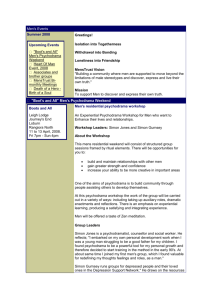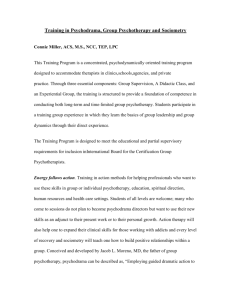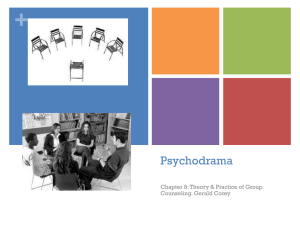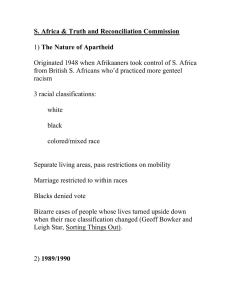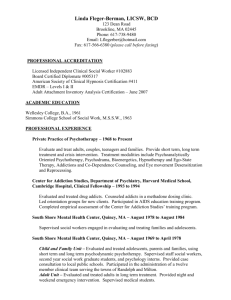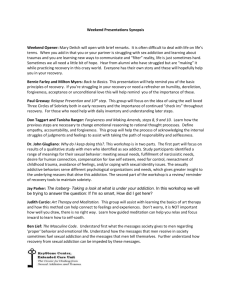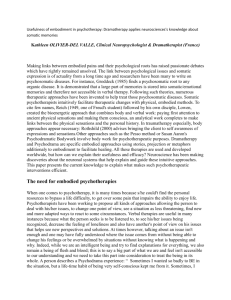Heart-Centered Energetic Psychodrama
advertisement
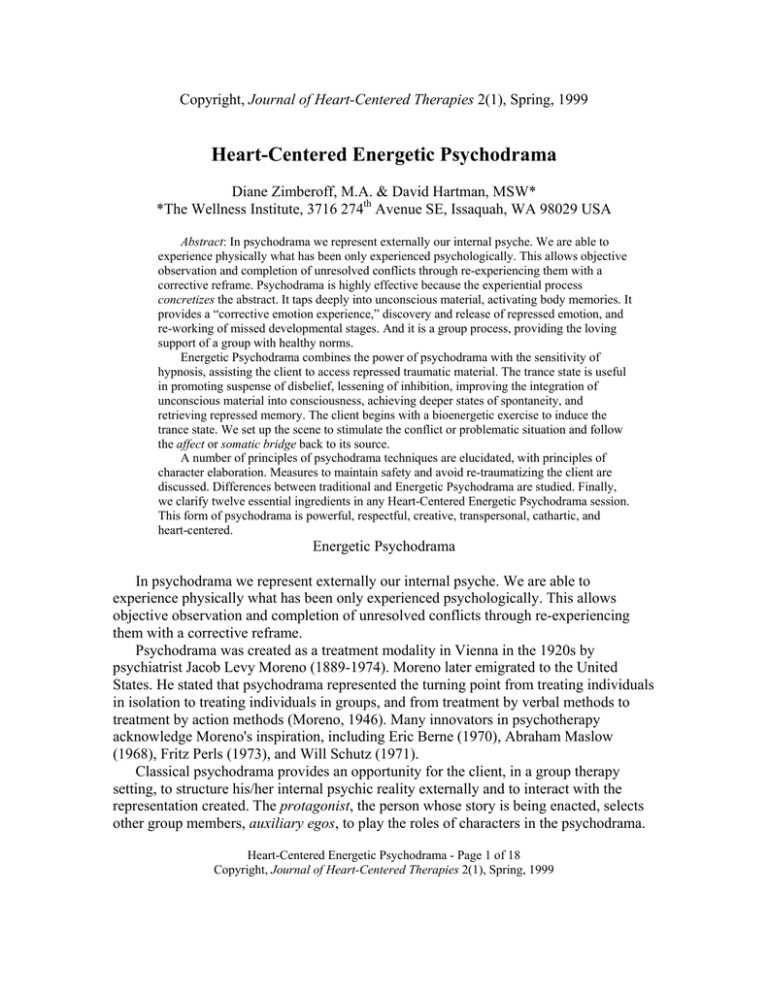
Copyright, Journal of Heart-Centered Therapies 2(1), Spring, 1999 Heart-Centered Energetic Psychodrama Diane Zimberoff, M.A. & David Hartman, MSW* *The Wellness Institute, 3716 274th Avenue SE, Issaquah, WA 98029 USA Abstract: In psychodrama we represent externally our internal psyche. We are able to experience physically what has been only experienced psychologically. This allows objective observation and completion of unresolved conflicts through re-experiencing them with a corrective reframe. Psychodrama is highly effective because the experiential process concretizes the abstract. It taps deeply into unconscious material, activating body memories. It provides a “corrective emotion experience,” discovery and release of repressed emotion, and re-working of missed developmental stages. And it is a group process, providing the loving support of a group with healthy norms. Energetic Psychodrama combines the power of psychodrama with the sensitivity of hypnosis, assisting the client to access repressed traumatic material. The trance state is useful in promoting suspense of disbelief, lessening of inhibition, improving the integration of unconscious material into consciousness, achieving deeper states of spontaneity, and retrieving repressed memory. The client begins with a bioenergetic exercise to induce the trance state. We set up the scene to stimulate the conflict or problematic situation and follow the affect or somatic bridge back to its source. A number of principles of psychodrama techniques are elucidated, with principles of character elaboration. Measures to maintain safety and avoid re-traumatizing the client are discussed. Differences between traditional and Energetic Psychodrama are studied. Finally, we clarify twelve essential ingredients in any Heart-Centered Energetic Psychodrama session. This form of psychodrama is powerful, respectful, creative, transpersonal, cathartic, and heart-centered. Energetic Psychodrama In psychodrama we represent externally our internal psyche. We are able to experience physically what has been only experienced psychologically. This allows objective observation and completion of unresolved conflicts through re-experiencing them with a corrective reframe. Psychodrama was created as a treatment modality in Vienna in the 1920s by psychiatrist Jacob Levy Moreno (1889-1974). Moreno later emigrated to the United States. He stated that psychodrama represented the turning point from treating individuals in isolation to treating individuals in groups, and from treatment by verbal methods to treatment by action methods (Moreno, 1946). Many innovators in psychotherapy acknowledge Moreno's inspiration, including Eric Berne (1970), Abraham Maslow (1968), Fritz Perls (1973), and Will Schutz (1971). Classical psychodrama provides an opportunity for the client, in a group therapy setting, to structure his/her internal psychic reality externally and to interact with the representation created. The protagonist, the person whose story is being enacted, selects other group members, auxiliary egos, to play the roles of characters in the psychodrama. Heart-Centered Energetic Psychodrama - Page 1 of 18 Copyright, Journal of Heart-Centered Therapies 2(1), Spring, 1999 The director, the professional who leads the group, sets the stage and directs the psychodramatic action based on the intentions of the protagonist. A double, the supportive inner voice of the protagonist, can play the role for the client when it is too traumatic for the client him/herself to re-enact the scene. The group members are referred to as the audience. The protagonist may enter a trance state, similar to a dream state, surrounded by the manifestation of his/her psyche. Psychodrama is a method of treatment that follows people into their inner reality, allowing them to describe it and work with it as they see it. Through dramatic action the psychodramatist brings longburied situations to the surface to relieve emotional pressure, creates a ‘holding’ environment through sharing, support and acceptance, and then allows the natural healing forces of the psyche and the emotional self to continue to work (Dayton, 1994, p. 1). Psychodrama is highly effective because it is experiential, it taps deeply into unconscious material, it is corrective, and it is a group process. Experiential Psychodrama is experiential. It allows an internal experience to be externalized and experienced from a new perspective. For example, the impact on a client’s life of overwhelming responsibilities is immeasurably more powerful experienced in a visual and physical way than it is merely discussed verbally and known cognitively. Moreno called this phenomenon "action insight" and observed that it is often more powerful and enduring than verbal insights (Blatner & Blatner, 1988, p. 79). Participation in the psychodrama is spontaneously so engaging that people experience some degree of suspended disbelief. The client and those playing roles “get into the action” to the extent that it becomes the foreground reality and the sense of being a spectator recedes. This occurs in Energetic Psychodrama for the client and other group members since all are experiencing a somewhat altered state of consciousness. Lewis Yablonsky (1976) quotes one of his clients to highlight the benefit of some form of action in therapy. A protagonist who flourished in a combination of psychodrama and individual therapy after several years of moderate progress in a strictly individual talk therapy made the following observation on the necessity of an action method in her life: ‘I went to several shrinks. I must admit I learned a lot, but I also found it frustrating. When I would get into the anger that I turned on myself in the form of depression, I wanted to scream and break things. But there I would sit on my hostility. ‘One of my therapists had an office full of fine furniture, plants, and antiques. The scene totally mitigated against my really expressing my anger. If I blew up, like I have many times in psychodrama, I would have busted up several thousand dollars’ worth of furniture. I might pour coffee or break an ashtray on his Oriental carpet. ‘Also I couldn’t yell or scream because of the people in the outer office. So I sat there like a good polite little patient talking about my depression, which never went away until I opened up in psychodrama’ (p. 22). Heart-Centered Energetic Psychodrama - Page 2 of 18 Copyright, Journal of Heart-Centered Therapies 2(1), Spring, 1999 Another aspect of the experiential nature of psychodrama is concretizing the abstract. We know from Piaget's work that children under the age of twelve think concretely rather than conceptually. Children and adults experience overwhelm (or anxiety, or fear, or many other emotions) in their bodies with nervous tension, dread, a “fight/flight/freeze” response. Adults attempt, usually unsuccessfully, to access the state and to affect it or change it by thinking about it. Is it easier to understand and work on a complex relationship cognitively, or by creating a three-dimensional representation of it, complete with players, movement and sound? Engaging all the senses increases the concreteness of the experience. Some experiences, early pre-verbal memories, for example, are perhaps only accessible through such means. In psychodrama, we concretize experience visually, kinesthetically, and viscerally. For example, a family sculpture (a technique popularized by Virginia Satir), with family members placed physically in relation to each other, could demonstrate visually how distant the antisocial brother is and how clinging the oversolicitous mother is. “One picture is worth a thousand words.” Sixty percent of all people process information kinesthetically. Experiencing the opposite pulls of one’s spouse and job physically, kinesthetically, is often more helpful than any amount of talk regarding the conflicting responsibilities. And the actual internal, visceral feeling that is aroused when the senses are engaged adds a great deal to the treatment process. Examples of what can be concretized are: Assigioli's concept of subpersonalities (1971), Jung’s concept of the shadow, obstacles, losses, conflicts, saying goodbye, burdens, disease, developmental stages, social or family roles, authority figures, others' expectations, appropriate boundaries, idealized fantasies, the feeling of isolation, suffocation, fears, defense mechanisms, needs, innocence, and incongruities between one's inner and outer expression. Accessing the deep unconscious Engaging the body kinesthetically activates body memories, which take us like sonar to early traumatic experiences or other deeply held unconscious material. The body created a neurotic response to a traumatic stimulus under state-dependent learning conditions, and has stored the association physically. The body, not only the brain, contains the unconscious mind. The body physically encodes its learned symptoms, neurotic coping mechanisms, and decisions in the limbic-hypothalamic systems. Healing occurs by accessing the encoded learned responses, following the affect or somatic bridge back to the state in which they were learned, and reframing them. Repressed emotions and the behavior patterns which they create are stored in the body, and can best be released by returning to the state in which they were created (Zimberoff & Hartman, 1998, pp. 1314). Marsha One example of this is a young woman named Marsha. She was reporting feeling depressed, overwhelmed and somewhat hopeless in her life. Marsha also reported severe neck and shoulder pain as well as sporadic migraine headaches. She was a school teacher Heart-Centered Energetic Psychodrama - Page 3 of 18 Copyright, Journal of Heart-Centered Therapies 2(1), Spring, 1999 who loved the children, but who felt drawn into the battlefield between the parents, the other teachers, the school administration and the children. The scenario was that parents would come in and blame the teachers for some problem the child was having. They would go to the school administration to complain. Marsha felt totally unappreciated, blamed, and caught in the middle. She also felt that the parents were not taking responsibility for their part in their child’s problems. As the psychodramatic scene was set, people were assigned to play the parents, the children, the school administrators, and the other teachers. Marsha was directed to stay with her own feelings and somatic experiences. As the scene progressed, the director became aware that what was being acted out was the Victim Triangle (Berne, 1964; Zimberoff, 1989). When she was directed to play the teacher, she fully experienced being the victim as the school parents and administrators put her in the middle, blaming and persecuting her. As she was directed to “speak up” for the teachers, she turned into the persecutor, blaming the parents and the administrators for not doing their part. She was then directed to take on the role of the children, using the role-reversal technique. It was at this direction that Marsha most profoundly experienced being the victim, feeling helpless and overwhelmed as she watched all the adults fighting and no one really paying attention to her. This was the key. She was then directed, “Let yourself go back to a significant time in your life where you had this same feeling. Go back to what this is really about for you.” Marsha was almost immediately back in her family of origin. New characters to represent her parents, siblings, grandparents and the church were quickly brought in. Here was poor little Marsha witnessing the fighting of her parents over how to raise her. The mother was a devout Christian, siding with the church to control her with Christian values and morals. Fighting against them were the father and grandparents who felt the mother and the church were too strict. This experience was effectively concretized by tying a sheet around Marsha, and having the persecutors (mom and church) pulling at her from one side and the rescuers (dad and grandparents) pulling at her from the other side. This physically recreated the emotional experience of feeling victimized, helpless and overwhelmed. As this was happening, she began having the body memories of a headache and neck pain. Then, the final aspect came when she began to feel protective of her younger siblings and wanted to prevent them from having this same helpless experience. This is when she moved from helpless victim to rescuer. She felt severe pressure to protect her siblings from the church and her mother. As she responded to these situations, she was directed to continue to pay attention to her body and to the way in which she switched from victim to rescuer to persecutor in an effort to move out of the helpless role of victim. She soon began to experience that each of these “roles” always led back to victim. The focus then returned to her current life conflict (teaching) from the regressed conflict (the parents, grandparents, Church and siblings). The school parents were analogous to Marsha’s own persecuting mother, while the school administrators were the church or authority figures. The teachers represented the rescuers, similar to her father and grandparents, protecting her from the authority figures. And it was the children, who Heart-Centered Energetic Psychodrama - Page 4 of 18 Copyright, Journal of Heart-Centered Therapies 2(1), Spring, 1999 Marsha had fiercely protected, who represented her own inner child as well as her siblings. She was then directed to begin taking back her personal power by pushing pillows against the persecutors in her life and telling them her “truth.” By doing this, she began experiencing the difference between rescuing and truly taking back power. As Marsha stood up to her persecutors and reclaimed her adult, her headache and neck pain began to leave. This is the way in which the protagonist can have a corrective experience, by actually responding from their powerful adult instead of their victim child. The body will confirm when the healing has taken place. Subsequently, Marsha has described that psychodrama session as the turning point in her healing. For the first time, she fully experienced how she was continuing to perpetuate her childhood reality of being trapped in the Victim Triangle. She physically experienced how that trap works and how she moved from one position to the next, but never saw the way out. Through her psychodrama, she learned the difference between clearly taking power as an adult versus being a child and acting as if one has power by rescuing or persecuting. This has moved her into a powerful personal transformation in her life. And, she became free of headaches and neck tension. Corrective experience Contemporary psychoanalysts such as Heinz Kohut have charted a revised course for their patients from the neutrality and distance required of the analyst in classical Freudian analysis to empathy, respect for the patient’s subjective experience, and “corrective emotional experience” (Alexander & French, 1946; Kahn, 1991). The existential and humanistic therapists who emerged in the 1950s as an alternative to psychoanalysis and behaviorism almost uniformly incorporated a “corrective emotional experience” as essential to effective intervention. “Psychodrama is inherently corrective.” (Dayton, 1994, p. xix) In psychodrama we can re-write history. We can react differently than we did originally, saying what we couldn’t then, protecting what we couldn’t then, setting much-needed boundaries. A client can see the abused child that was him/her sympathetically, contrary to the judgments and shame which have filled his/her self-experience ever since. This correction often takes the form of re-working missed developmental stages. The corrective experience encourages the client toward "re-experiencing the old unsettled conflict, but with a new ending" (Alexander & French, 1946, p. 338). Releasing repressed emotion is also corrective. Clients often find their feelings and emotions are more accessible to them in the altered-state created with experiential techniques. They are often also more willing to express those feelings with less inhibition. Geri An example in point is Geri. Geri was plagued with feelings of guilt, unworthiness and extreme anxiety. Even though she was a beautiful, talented young woman, no amount Heart-Centered Energetic Psychodrama - Page 5 of 18 Copyright, Journal of Heart-Centered Therapies 2(1), Spring, 1999 of praise could erase her low self-esteem and lack of self-confidence. She also suffered from chronic sore throats, which often caused her to miss important events in her life. Geri’s psychodrama session began with a current life situation in which she missed a long-planned vacation with friends because of a severe sore throat. When her friends called her to let her know how much they missed her, she interpreted the call as a critical guilt trip from which she felt pressured and shamed. Instead of feeling the love coming from her friends, she experienced the anxiety of never being able to please them. As Geri acted this out, she was catapulted back to the family of origin scene of her mother yelling at her as a child and calling her horrendous names. The mother, obviously mentally disturbed, was over reacting to some small incident by calling six-year-old Geri a bitch and a dirty slut. Geri was devastated and filled with fear and shame. She was immobilized by her anxiety, her head hung down and she reported a sudden sore throat which prevented her from speaking. Young Geri was then directed to “bring in” her strong adult self to take over for the child. She was pushing against her mother, pillows in between them as a protective distancing, and standing up to her mother, speaking the truth that the child had been unable to express. The power that resulted from the full expression of her inner truth was most impressive. She spoke eloquently, as never before, to inform her mother how she did and did not want to be treated. She set clear boundaries from her adult ego state in a powerful effort to protect the “inner child” from further abuse. As she did this, a smile came over her face as she noticed the immediate freedom from her throat pain. She was amazed at the clear connection between her sore throats and her childhood inability to express herself in the face of her mother’s frightening criticism. In the final scene, she used pillows to represent all the negativity she was “giving back” to her mother. She named each thing she wanted to let go of, such as the criticism, the shame and the anxiety. She took one pillow after another and shouted, “I’m giving you back all of your fears,” and then she threw the “fear pillow” back to her mother. She continued until all the internalized emotions had been given back. Then she was directed to “reclaim” what she wanted to take back from her mother. At that point Geri began reclaiming her power, her self-esteem, her courage, each represented by a pillow that was handed to her. She held on tightly to all the parts of herself that she reclaimed from her mother. Her psychodrama ended with feelings of power and self-esteem along with the relief of her throat constriction. She thanked her throat for being a barometer to inform her when she was suppressing her truth. And she vowed to always pay attention to the messages of her body. When Geri next returned, she was jubilant to report that she had made personal contact with her mother and was able to tell her clearly from her adult ego state how she wanted to be treated. She let her mother know that any shameful name-calling would mean the end of their relationship. She was able to express her feelings from a place of self-love rather than from the hurt and angry child. Geri continues to make progress in healing the relationship with her mother and says the foregoing psychodrama session was the turning point in this process for her. Heart-Centered Energetic Psychodrama - Page 6 of 18 Copyright, Journal of Heart-Centered Therapies 2(1), Spring, 1999 The corrective experience can be hearing a change of heart in the characters in the drama, that is reformed auxiliaries (Sacks, 1970). To hear one’s abusive father apologize, or a critical teacher praise the client’s school work, can be immensely healing. It can also serve the individual to rehearse, through role-training, a new way of relating in an existing relationship. However, this technique must be used carefully. It would be unfortunate to set up an unrealistic expectation of someone in the client’s current life by having that person’s role-player “reform” only to painfully discover upon returning home from the psychodrama group that the person has not reformed. Group process Psychodrama is a group process. Some issues, particularly shame, are most readily treated in a group rather than individually. The ultimate release of shame requires that one acknowledge shameful behavior to a group of peers, release the judgment of shame, and receive loving acceptance in spite of it. The loving support of a group with healthy norms is invaluable to healing many issues in addition to shame, and provides the ongoing reinforcement necessary to make behavior change permanent. Advantages of group work also include the efficiency of benefit to multiple group members of one member’s session. Often, the participants who play roles in a session, or those in the non-participating audience find their issues getting triggered during someone else’s session. Also, participants benefit from the modeled social learning provided by observing other members' coping strategies, resilience, and triumphs (Bandura, 1971). Tammy and Nicki For example, Tammy was working on the loss of her mother when she was a young child. She was being directed to express the long-standing grief that she had previously been unable to express. Her touching expression of grief and loss triggered deep feelings in another woman, Nicki, who had just lost her father but had been restricted in releasing her grief. As Nicki sat in the circle with tears streaming down her face, another group member was directed to sit with her and hold her. This technique gives support to the group members who become triggered before it is their turn to be protagonist. Sometimes it can be appropriate to use a group member’s intense emotional engagement by assigning them a role in the current psychodrama. For example, asking Nicki to role-play Tammy’s sister could have provided a powerful cathartic release for Nicki, and an empathetic, permission-giving model for Tammy. This is one of the most important aspects of the group process. The group process brings to consciousness, what has previously been unavailable and unexpressed. The longer feelings are repressed, the more likely they are to turn into disease. Through the group psychodrama process, participants usually have at least one experience of discovering deeply repressed emotions and finding an opportunity to release them. Lewis Yablonsky describes how this transference/empathy effect of psychodrama can be utilized for the benefit of group members by intentionally selecting individuals for specific auxiliary roles. Heart-Centered Energetic Psychodrama - Page 7 of 18 Copyright, Journal of Heart-Centered Therapies 2(1), Spring, 1999 Sometimes auxiliary egos are selected on the basis of their own needs, or opportunities inherent in the situation for developing insight into themselves. For example, a young woman in the group has an alcoholic mother. A situation emerges in which I need someone to play an alcoholic mother. I would use the young alcoholic woman in that role. . . . In another session, a wife who felt she was constantly beseiged by her ‘oversexed husband’ was cast as an auxiliary ego in the role of the oversexed husband with a woman who had a similar problem. This enabled her to comprehend what it felt like to be the pursuer rather than the sexual object (Yablonsky, 1976, pp. 103-104). Psychodrama and Hypnosis There are many commonalities between the experience of the client in psychodrama and the client in hypnotherapy. Adam and Allee Blatner (1988) state that “psychodramatic enactment often generates a mild to moderate level of trance in the protagonist and other participants” (p. 121). In fact, J. L. Moreno developed hypnodrama in the 1940s and refined it as a technique with James Enneis, one of his principal students. Hypnodrama combines the power of psychodrama with the sensitivity of hypnosis, assisting the client to access repressed traumatic material. Enneis was working with shell-shocked soldiers during and immediately after World War II. Military psychiatrists at that time were administering hypnotic drugs or verbal inductions to incapacitated soldiers and encouraging them to relive the original traumas. This revivication technique was the most successful known treatment at the time. Enneis and Moreno collaborated in experimenting with hypnodrama, writing of their results beginning in 1950 (Moreno, 1950; Enneis, 1950; Moreno & Enneis, 1950). Moreno wrote, “Hypnodrama is a synthesis of psychodrama and hypnosis” (p. 6). What he refers to as hypnosis is the classical authoritarian style of hypnosis. “The usual routine of hypnosis of giving simple, verbal orders to the subject is transformed in the hypnodramatic experiment into a complete psychodrama” (p. 7). Here follows a description of the [hypnodrama] technique, some observations and recommendations. It is assumed that the hypnotic operation has a psychodramatic nucleus which has to be mobilized and treated in order that it should attain real effect. The hypnotic operation itself is reconstructed from a psychodramatic point of view in all its aspects, a) in the role of the hypnotist himself; he becomes a psychodramatic director, assisted by a staff or auxiliary egos, b) in the acts of bringing about the hypnotic sleep; it helps the warm up if the patient improvises on the stage the genius loci—his bedroom—if he goes to bed and assumes the position of the sleeper; and c) during the hypnotic trance of the subject the verbal suggestion of the hypnotist is replaced by a psychodramatic production. The patient is treated during the trance like a subject in a psychodrama session, he is changed into a psychodramatic actor; he is the protagonist who, in cooperation with the hypnotist-director and auxiliary egos externalizes the internal structure of his mental world. Although hypnosis is the starting point of a hypnodrama, the hypnotisand takes part in the production as the central character, he is exposed to a bombardment of psychodramatic stimuli and is suggested by the chief therapist to interact during the session with every auxiliary ego. The auxiliary egos materialize the persons, objects, images and scenes as they are projected by the patient. He often gives, upon instructions of the hypnodramatist, a soliloquized echo of every part played by an ego. Thus either he acts out or shapes the production step by step (p. 6-7). Heart-Centered Energetic Psychodrama - Page 8 of 18 Copyright, Journal of Heart-Centered Therapies 2(1), Spring, 1999 Enneis makes the case that hypnotherapists may be using psychodrama techniques, knowingly or unknowingly, and may do well to incorporate them to overcome some of the limitations of hypnotic therapy. Enneis credits hypnosis with facilitating for the client a more rapid acceptance of the auxiliary into the role, and a more rapid and less painful integration into consciousness of material presented under hypnosis. He also observed that memory for action taking place under hypnosis is greater than without it, and that there is a greater release of tension under hypnosis. Finally, Enneis attributed hypnosis with lessening inhibition and achieving deeper states of spontaneity. In abreaction and other procedures which utilize the patient's ability to place himself in situations, the therapist often consciously or unconsciously takes the role of one or more of the people involved, thus becoming an auxiliary ego. In addition, through suggestion he causes the patient to create hallucinatory auxiliary egos. The patient reveals his relationship to these persons and to the situations through verbalization and modified motor activities. Since the patient is usually mildly restrained by the therapist, his actions are inhibited. This constitutes a major block to catharsis, since the organism is not free to express itself in action. The patient is limited in his expression mainly to those feelings and emotions which fall within his vocabulary range. In hypnodrama the patient is free to act, and is given auxiliary egos to help portray his drama. Under these circumstances situations become more real and are more productive in the therapy of the patient (Enneis, 1950, p. 11). Eva Leveton (1992) compares psychodrama and hypnotherapy, noting “I believe that in both cases the subject is often in a trance” (p. 141). She enumerates several similarities: Both hypnotist and psychodramatist work toward a ‘joining’ with the patient. . . . The hypnotist paces his subject; that is, he works at the same pace that the subject is already using. The hypnotist analyzes his subject's primary way of perceiving the world and uses it to join the subject, only gradually leading him to a different experience through trance. Neither indulges in much repartee. The object for both is to become part of the protagonist's world, to help the protagonist change by infiltration rather than analysis, discussion, or role-modeling. . . . In psychodrama, the protagonist helps tell his own story, and yet, despite the fact that the characters and the plot are the same, finds himself continually surprised and challenged by it. He sees the familiar situation there on the stage, but he experiences it in the here and now and reacts spontaneously. . . . He is less defended. . . . Frequently he finds himself doing or saying things he had never dared do or say, things he didn't know he had in him. Both trance and pychodrama are founded in paradox. The hypnotist who says, 'You don't even have to listen to my voice' plans every word as a message to his subject's subconscious. The subject, free not to listen, listens to every word. The psychodramatist provides a cast of characters who frequently represent an exaggerated version of the difficulties and frustrations of the protagonist. But both the director and the cast of characters are there to help the protagonist. Both hypnotist and psychodramatist take full charge of the session. At the same time, both frequently give the protagonist the sensation of being fully in charge for the first time. In the paradox, spontaneity and creativity are born. . . . Both hypnotist and psychodramatist provide an experience that by definition is extraordinary and thus has some of the quality of ritual or 'heightened reality.' Unlike group and individual psychotherapies that rely mostly on the exchange of verbal information, psychodrama and hypnosis provide an arena where the subject can enter a different world, the world of the past, of Heart-Centered Energetic Psychodrama - Page 9 of 18 Copyright, Journal of Heart-Centered Therapies 2(1), Spring, 1999 the future, of heightened intensity. Both often make use of the ‘story’ to frame the subject's dilemma. . . . Not unlike shamanic rituals such as the medicine wheel or sand painting, psychodrama and hypnosis both place the subject in the very center of his dilemma and provide him means to explore it that are unfamiliar and traditional at the same time, lending a timeless dignity. . . . It is not uncommon for a subject to attend a hypnosis session or a short series of sessions once or twice in his life or to go once and then return for a follow-up several years later. The same is true of psychodrama. The 'healing' that takes place can be an event of momentous importance in the subject's life (pp. 140-143). Stages in the Psychodrama Session The session begins with the client revealing a previously created sociogram, representing family and other significant people in his/her life. This diagram provides a map of the cast of characters with whom the client is emotionally engaged for reference during the psychodrama. It is helpful for identifying relevant roles to be played in the scenes created, and for identifying the transference by the client onto group members. The directions for creating the sociogram are to draw a circle to represent yourself in the middle of a piece of paper. Then locate your significant relationships in circles on the paper, as close or distant from you as you feel them to be, and as big or small compared to you as you feel them to be. Draw lines between yourself and each of the others, labeling the line with a description of your emotional relationship. Engage in a brief interview with the client regarding their current emotional state and what they are aware of wanting to work on. Have the client select group members to play any roles anticipated for the work to be done. If a role-player is unclear about how to play the role, ask the client to ‘reverse roles’ and play that role briefly to demonstrate it to the rest of the group. Then have the client begin a bioenergetic “rock and breathe” exercise to induce the trance state and get the person’s energy moving in his/her body. Follow the affect or somatic bridge of the experience the client is in back to its source. Set up an interaction with appropriate characters from his/her life to clarify the circumstances and provide an opportunity for the client to understand the behavior pattern involved and to create a corrective experience. Finally, allow any group member, role-player or not, to share the experience they had during the session. It is validating for the client and important for the group members. Selecting the client to work The therapist will select the person who is to do a session using one of several criteria. One choice is to select the group member who is most ready to work, closest to their feelings or most “plugged in.” Another is to select a group member who isolates and needs to be brought into the center of the group’s energy, or to select someone whose issues are particularly relevant to the majority of group members. Everyone present can benefit from the work of one person through their identification and transference with the client. The group itself can select the person to work as well, by asking each member to indicate with whose issue they most resonate. Heart-Centered Energetic Psychodrama - Page 10 of 18 Copyright, Journal of Heart-Centered Therapies 2(1), Spring, 1999 Selecting the role players How you select role players depends on the therapeutic intentions. If you want to maximize the transference aspect of group member interactions, have the client select people to play the needed roles. If you want to maximize the benefit to group members of playing specific roles (as a form of role reversal) for their own clarity, assign people in the group to play particular roles. For example, it can be powerful for a woman angry with her husband for having an affair to play the ‘other woman’ in someone else’s psychodrama. Sally and Monty A most powerful example of this transference aspect came when Sally began working with her feelings of helplessness in her current relationship. Her boyfriend was a marijuana smoker and continually urged her to “get high” with him. She felt that he was “drugging” her in order to keep her under his control. Sally selected a group member to play her boyfriend, a highly controlling and demanding person with a somewhat abusive nature. With the boyfriend selected and described, the drama began. A chorus of others formed behind him urging her to “get high.” They then began making demands from her and physically pulling at the sheet tied around her waist. “Make my dinner,” “Let’s get high,” “I need you to wash my clothes,” “Go to the store” they shouted at her. As she became visibly shaken, Sally was asked, “What does this feel like to you? Go back to the source of this experience.” At this point, Sally regressed to a small girl being sexually molested by her stepfather. She described a scene of being in her bed at night when he comes into her room, forcing her to take a big swallow of an alcoholic drink. She hates the taste but he says it will help her relax. At this point she was too regressed to choose someone to play her step-father. One of the group members, Monty, had recently reported being sexually abused by his step-father. He realized that as a result of his abuse, he had a sexual addiction. When Monty was asked if he could play this role for his friend Sally, he thought about it carefully and then agreed. It was a difficult role for Monty to play, especially talking to Sally as a little child, enticing her to drink alcohol and to become sexual with him. As the scene went on, Monty got more involved in it and was able to fully participate. He later discussed how difficult it was for him at the beginning. But then he realized that it was helping him to understand his own childhood abuse by temporarily becoming the abuser. He was subsequently able to forgive his own step-father for the abuse he had perpetrated. Sally was grateful to Monty for the powerful support he had given her. She was able to see her pattern of attracting men who want to keep her “drugged” so that they can control and abuse her. It was the first time that she so clearly experienced how she continually re-created this early relationship as a helpless victim. Principles of Psychodrama Techniques Heart-Centered Energetic Psychodrama - Page 11 of 18 Copyright, Journal of Heart-Centered Therapies 2(1), Spring, 1999 These guidelines for selecting techniques in the psychodrama are based in part on a discussion by Adam and Allee Blatner (1988, pp. 151-152). 1. Use physical action rather than narrative. 2. Have people directly address characters in the drama rather than talking about them. 3. Re-create specific scenes, making the abstract more concrete. 4. Emphasize increasing levels of self-disclosure and honesty about feelings. 5. Address the group dynamics to facilitate conflict resolution, group cohesiveness, and ultimately create a safe, healthy therapeutic community. 6. Allow and reinforce playfulness and spontaneity in group members. 7. Include everyone in playing roles in sessions to avoid overinvolvement by some and isolation by others. 8. Be prepared to meet the cathartic needs of each person in the group as they arise. 9. Exaggerate and amplify behavior or attitudes to explore a wider range of responses. Principles of Character Elaboration These guidelines for how to successfully play a role in the psychodrama are based in part on a discussion by Adam and Allee Blatner (1997, p. 53). 1. Be subjective. Use “I” and allow your inner intuitive experience to guide you in how to play the role. 2. Use the present tense, be in the scene now regardless of where and when it originally took place. 3. Set the interaction up by informing the protagonist of who you are and use the specific words and terms that the protagonist attributed to you. 4. Emphasize emotional states, and express the emotions dramatically. 5. Amplify the characterization by giving more details of what you are feeling. Explore the character. 6. Express the unspoken. Often there were covert threats, rules, or manipulations that can be made overt for more clarity. 7. Focus on the relationship, and the dynamics of the others in the system. 8. Remember that you are playing the role for the benefit of the client/protagonist and avoid the tendency to get personally involved in the struggle. Stop immediately when directed to do so by the facilitator. 9. Always have a clear, explicit de-roling from the protagonist: “I know you are not my sister Jenny. You are my friend and colleague Sarah.” Variations of the Work Dream and fantasy work Heart-Centered Energetic Psychodrama - Page 12 of 18 Copyright, Journal of Heart-Centered Therapies 2(1), Spring, 1999 Psychodramas can be created around dream material, drama characters being the most vivid elements of the dream. This experience concretizes the protagonist's inner use of symbol and metaphor. The same technique helps to elucidate fantasies. Subpersonalities Psychodramas can be created around subpersonalities (Assigioli, 1971). Characters might include ‘the shadow side’ (e.g., a self-destructive part, an antisocial part, or a violent part), inner children of various developmental stages (e.g., the two-year-old brat or the seductive sixteen-year-old), idealized characters (spouse, boss, children, self), or conflicted parts (e.g., the responsible part that always fulfills obligations and the rebellious part that wants to ignore them). Birth issues “I don’t deserve to exist” could be a birth issue. In psychodrama after the induction, ask the person, "Where are you?" If the response is, "In the womb," treat the session as a rebirth until the client is out of the birth canal, using breath therapy techniques. Then fast forward to the current conflict issues discussed in the interview. For example, if the client experienced the sense that “I don’t deserve to exist” in her relationship with her husband, the therapist may create a psychodrama scene with an auxiliary playing him. Lois Lois started her session with the awareness that her mother did not bond with her at birth. This resulted in Lois promiscuously trying to get the need met through sexual relationships with men as an adult. When she rocked and breathed to begin the induction, she couldn’t identify any feeling. The birth experience (being stuck and disconnected) was simulated by having her physically push against some pillows. As she gained more of a sense of personal power, she psychodramatically dealt with the men from whom she had tried unsuccessfully to get her nurturing needs met. She realized the impossibility of getting what she really wanted using the unconscious strategy of selecting emotionally unavailable men. Then she fully experienced accepting the very real nurturing support within the group, and anchored that sense of autonomy and "non-neediness" so that she could bring it back in times of weakness with the boyfriend she wanted to leave. When and how does the therapist transition between the breath therapy and the psychodrama? Start with and complete the rebirthing, grow the person up by suggestion (“Feel yourself growing up now, growing up and getting older, getting more confident within yourself”), and then use the psychodrama process with current life conflicts. Future progression techniques This method involves having the protagonist explore an anticipated event through acting it out. It allows one to extrapolate current patterns, goals, behaviors, etc. to clarify what one is in fact creating. This technique also allows one to rehearse various alternative choices to “try them on for size.” Would I like this relationship if I pursue it? Would I Heart-Centered Energetic Psychodrama - Page 13 of 18 Copyright, Journal of Heart-Centered Therapies 2(1), Spring, 1999 enjoy the reality of having children if I decide to have them? Would I be able to tolerate the rejection I expect from my family if I tell the truth about my father’s incest? Maintaining Safety and Avoiding Re-traumatizing the Client Keep control Keep control of the session to maximize the sense of security and safety of all participants. The facilitator(s) is to be the only one directing the client or the role-players. Coach the client The facilitator must maintain close (intimate) contact with the client throughout the session – being a “lifeline,” providing encouragement and validation, maintaining safety. The therapist must maintain close emotional and psychic connection with the client so that he/she can feel the therapist’s presence. Always remain the clear advocate Never contaminate the safety of the facilitator role by playing any other role. That’s what the group members are for – enroll someone to play any role needed. The therapist always remains the clear advocate for the client. Manage the trance Manage the trance through: 1) breath, e.g. remind the person to breathe if they begin dissociated shallow breathing; 2) physical activity such as energy release, concretely representing psychic activity (throwing pillows, being smothered with pillows, being pulled in different directions); or 3) pacing the facilitator interactions. Also manage the “telephoto” trance state and the “wide angle” state through energy release (Zimberoff & Hartman, 1998). Stage the action carefully Stage the action carefully to keep the person’s attention focused in one direction. Preferably locate role players immediately in front of the client and just beyond arm’s length. Unless the purpose is to demonstrate to the client how confused and competitive their mutually exclusive activities are, minimize the chaos by keeping it localized. Always follow the client Never pre-script the session because the therapist may not know what is most appropriate for the client to work on at this time. When in doubt about the direction to take, ask the client. Be prepared to "turn on a dime" when your client changes direction. Use stand-ins Use role-players for any character in the group (any member or the therapist) that needs to be in the drama. People should never play themselves. Also, use stand-ins for the Heart-Centered Energetic Psychodrama - Page 14 of 18 Copyright, Journal of Heart-Centered Therapies 2(1), Spring, 1999 client (double) in any scene that is potentially so traumatic that it may risk retraumatizing him/her. Share after sessions Share briefly after each session. Process any feelings generated during the psychodrama for any group member. This provides validation for the client and for the group members. Sharing should be the expression of relevant, vulnerable feelings, not feedback or advice. End the session with heart-centered love Always end the session with heart-centered love. Bring the person to empowerment, self-acceptance, an enlarged perspective, the nurturance of a corrective experience, clarity of new life decisions and safety of support for healthy choices. The closing of sessions on a high note is a cardinal principle of psychodrama. This applies also in hypnodrama. When the patient has enacted frustrating experiences, it becomes extremely important that he be warmed up to a pleasant situation which he can handle to his satisfaction before he is awakened (Supple, 1962, p. 288, quoting Moreno from Psychodrama vol. I). Differences between Traditional and Energetic Psychodrama In Energetic Psychodrama the therapist is never engaged in playing any role. Many classical psychodramatists regularly use the position of director to assume auxiliary roles in the client's session. Blatner indicates that the use of a third person, a trained co-therapist who is clearly present to act as an auxiliary by playing the role of a nurturing parent, can help the patient have a 'corrective emotional experience.' The role of a confronting significant other is also often more effective if played by someone other than the therapist. Blanck & Blanck (1979) noted that the therapist should be a catalyst, in the sense of being a necessary presence without participating in the action (1988, p. 116). In Energetic Psychodrama the therapist never has any relationship with the client other than objective therapist and personal coach. Playing the role of a client's projection can only confuse and contaminate the relationship between therapist and that client. We deliberately reduce the complications of transference. This is an intention of psychodrama in general. By limiting the repertoire of roles assumed by the therapist to essentially one, we reduce the complications to a minimum. The logic of psychoanalysis is to take advantage of the transference of the patient, to work through the resistance he has to returning the repressed to consciousness. The logic of psychodrama is different and more complex . . . whatever amount of projected transference operates from the patient towards the therapist is pushed into the background or reduced to a small element. Positive factors which are shaping the relationship and interaction in the reality of life itself take their place (Moreno, 1950, p. 2-3). Heart-Centered Energetic Psychodrama - Page 15 of 18 Copyright, Journal of Heart-Centered Therapies 2(1), Spring, 1999 In Energetic Psychodrama the re-enactment of a current conflict or experience is usually preparation for an age regression to earlier, underlying source trauma. For example, one's abhorrence for the boss at work is an emotional trigger, leading naturally to a similar relationship with an early critical teacher, and ultimately to an abusive father. The connecting cord between these experiences is the affect bridge (Watkins, 1971) of rage, or anxiety, or powerlessness. We follow that bridge in psychodrama just as we do in hypnotherapy. The inclusion of age-regressed scenes helps the person to see lifelong patterns of behavior, and the original decisions that they are based on. For example, one man recognized in this way that his lifelong struggle with authorities began when he decided as a young child that he must fight his abusive father's treatment to protect his helpless mother. Each time he did he was punished, which reinforced both his decision that authorities are unfair and his resolve to fight them. Jean A woman began her psychodrama session with an almost rageful irritation at a neighbor who told long, boring stories. Jean felt she couldn't be rude to the man because he was significant to her husband. We re-enacted the scene, and she vented her anger at the man in a way she never had in real life. In the aftermath of the fury of her emotional release, the facilitator asked Jean, "Who else do you need to express these feelings to?" She immediately realized that it was her pathetic brother who droned on endlessly about his problems whenever Jean talked with him. Then she recognized that she had the same relationship with her sister, who was a proselytizing born-again Christian who dominated every conversation with her advice to Jean on religious matters. Jean was able to create an internal calm patience, and used it to practice being in the presence of her (auxiliary) brother and sister and neighbor without experiencing her customary internal seething anger. She stated later that she had never consciously made the connection between her reaction to the neighbor and her relationship with the only two living members of her family, her brother and sister. In Energetic Psychodrama the client is deliberately induced into a trance state, and that hypnotic state is managed throughout the session. The induction is created by bioenergetic activity and breathing, rather than through a traditional eye-fixation hypnosis induction, and the depth of trance is managed with the same techniques. The trance state is useful in promoting suspense of disbelief, lessening of inhibition, accessing unconscious material, and retrieving repressed memory. Heart-Centered Energetic Psychodrama sessions share the following qualities: 1. 2. 3. 4. 5. 6. Include an enlarged perspective of life-long or karmic patterns. Incorporate a corrective emotional experience and new life decisions. Always end with self-acceptance and heart-centered love. Trance management is a key to success in any session. Energy release is usually very important in any session. Uncovering, identifying, expressing and releasing emotions (catharsis) is nearly always present in any session. Heart-Centered Energetic Psychodrama - Page 16 of 18 Copyright, Journal of Heart-Centered Therapies 2(1), Spring, 1999 7. Combine a balance between expansive abstraction (the “wide angle lens” state) and focused concreteness (the “telephoto lens” state). 8. Dual level of awareness (the “doer” and the “observer”) in each state creates more objectivity, less defensive examination, more experimentation with variations of behavior or belief, and more self-acceptance (of the blamed and reviled inner child). 9. Reduce the transference complication of psychoanalytic or talk therapy. 10. Strengthen the ego, empowering the client (Slavson, 1955). 11. Confront existential issues, e.g., the meaning or purpose of this earthly life, “Why am I here?” or “Who am I? ” (Yalom, 1985). 12. Incorporate a spiritual connection determined by the client, not proselytized or judged by the therapist. This form of psychodrama is powerful, respectful, creative, transpersonal, cathartic, and heart-centered. References Alexander, F. & French, T. M. (1946). Psychoanalytic Therapy: Principles and Applications. New York: The Rothald Press. Assigioli, R. (1971). Psychosynthesis: A Manual of Principles and Techniques. New York: Viking Press. Bandura, A. (1971). Social Learning Theory. New York: General Learning Press. Berne, E. (1964). Games People Play: The Psychology of Human Relationships. New York: Ballantine. Berne, E. (1970). Letter to the Editor. American Journal of Psychiatry, 126 (10), 1520. Blanck, G. & Blanck, R. (1979). Ego Psychology - II. New York: Columbia University Press. Blatner, A., and Blatner, A. (1988). Foundations of Psychodrama: History, Theory, and Practice. New York: Springer Publishing Company. Blatner, A., and Blatner, A. (1997). The Art of Play: Helping Adults Reclaim Imagination and Spontaneity. New York: Brunner/Mazel. Dayton, T. (1994). The Drama Within: Psychodrama and Experiential Therapy. Deerfield Beach, FL: Health Communications. Enneis, J. M. (1950). The hypnodramatic technique. Group Psychotherapy, 3(1), 11-54. Enneis, J. M. (1952). Establishing a psychodrama program. Group Psychotherapy, 5(2), 111-119. Greenberg, I. A. (Ed.). (1974). Psychodrama: Theory and Therapy. New York: Behavioral Publications. Greenberg, I. A. (Ed.). (1977). Group Hypnotherapy and Hypnodrama. Chicago: Nelson-Hall. Kahn, M. (1991). Between Therapist and Client: The New Relationship. New York: W. H. Freeman. Leveton, E. (1992). A Clinician's Guide to Psychodrama. New York: Springer Publishing Co. Maslow, A. H. (1968, August 2). Letter to the Editor. Life, p. 15. Moreno, J. L. (1946). Psychodrama: Volume One. Beacon, NY: Beacon House. Moreno, J. L. (1950). Hypnodrama and psychodrama. Group Psychotherapy, 3(1), 1-10. Heart-Centered Energetic Psychodrama - Page 17 of 18 Copyright, Journal of Heart-Centered Therapies 2(1), Spring, 1999 Moreno, J. L., & Enneis, J. (1950). Hypnodrama and Psychodrama. Beacon, NY: Beacon House. Perls, F. (1973). Shuttling, psychodrama, and confusion. The Gestalt Approach & Eye Witness to Therapy. Palo Alto, CA: Science and Behavior Books. Sacks, J. M. (1970). The reformed auxiliary ego technique: A psychodramatic rekindling of hope. Group Psychotherapy, 23, 118-126. Schutz, W. (1971). Here Comes Everybody: Body-Mind and Encounter Culture. New York: Harper & Row. Slavson, S. R. (1955). Group psychotherapies. In J. McCary (Ed.), Six Approaches to Psychotherapy. New York: The Dryden Press. Supple, L. (1962). Hypnodrama, a synthesis of hypnosis and psychodrama: A progress report. Group Psychotherapy, 15(1), 58-62. Watkins, J. G. (1971). The affect bridge: A hypnoanalytic technique. International Journal of Clinical and Experimental Hypnosis, 19, 21-27. Yablonsky, L. (1976). Psychodrama: Resolving Emotional Problems through Role-Playing. New York: Basic Books. Yalom, I. D. (1985). The Theory and Practice of Group Psychotherapy (3rd ed.). New York: Basic Books. Zimberoff, D. (1989). Breaking Free from the Victim Trap: Reclaiming Your Personal Power. Wenatchee, WA: Wellness Press. Zimberoff, D., & Hartman, D. (1998). The Heart-Centered Hypnotherapy modality defined, Journal of Heart-Centered Therapies, 1(1), 3-49. Heart-Centered Energetic Psychodrama - Page 18 of 18 Copyright, Journal of Heart-Centered Therapies 2(1), Spring, 1999

